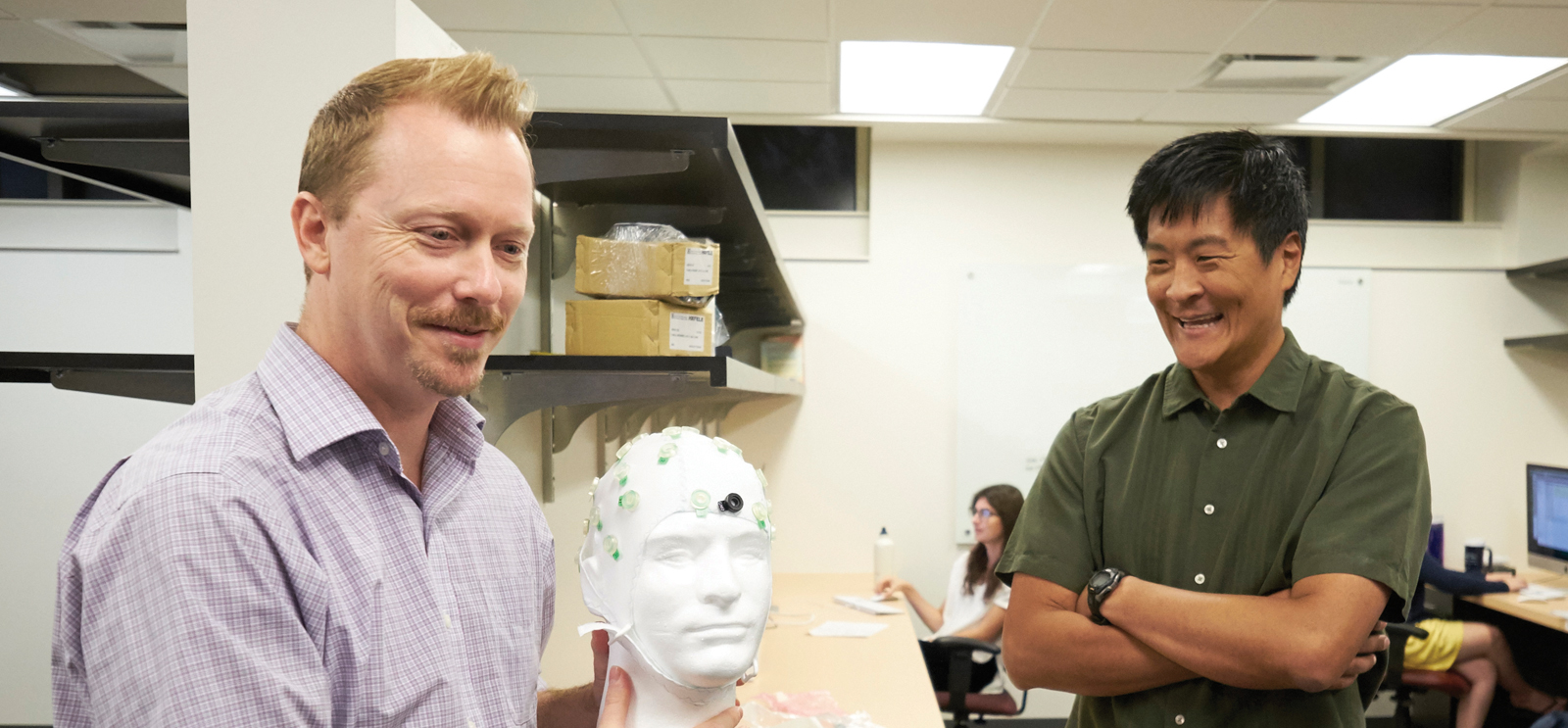
By studying concentration and memory, Vogel (left) and Awh extend the scientific understanding of human attention. (Photography by Joel Wintermantle)
Neuroscientists Ed Awh and Ed Vogel can read thoughts and tell the future. Sort of.
In the Biopsychological Research Building basement, Ed Vogel swings open a metal door, revealing a metal-lined closet-sized compartment. Vogel and fellow neuroscientist Ed Awh, collaborators since 2001 who share a lab, will use these electromagnetically shielded booths that block external noise and electronic interference to measure neural activity, signals as small as a millionth of a volt.
The sparse room will be cozied up with carpet, a desk, and a chair before subjects are closed in. “Don’t worry,” assures Vogel, “there’s a handle on the inside.”
Vogel and Awh joined the Department of Psychology; the Grossman Institute for Neuroscience, Quantitative Biology, and Human Behavior; and the Institute for Mind and Biology in July, coming from the University of Oregon. At UChicago they continue to study how people visually take in information from the world and hold that information to make decisions and act. They also study our ability to focus attention and tendency to lapse into distraction.
Their teams investigate cognitive variance, which is what makes certain memory tasks difficult or easy and explains why some individuals are better at these tasks than others. “Working memory and attention are strongly predictive of IQ and scholastic achievement,” says Awh. Memory and attention abilities are also involved in disorders such as schizophrenia, depression, and attention deficit hyperactivity disorder; better understanding these systems’ normal operations could help diagnose and rehabilitate those disorders.
The neuroscientists measure cognitive ability through both behavioral performance and neural activity. To measure behavioral performance, they instruct subjects to look at a computer monitor showing small amounts of information—a certain color or shape in a certain position, for instance—as well as distractors. Subjects are asked to focus on and remember certain elements, which increase in complexity, and press buttons that record their reaction times and accuracy.
“People with excellent memory function tend also to have excellent attention function,” says Awh. “Those two capacities are closely intertwined.”
Behavioral performance research provides the foundation for Vogel and Awh’s neural activity research, primarily conducted by electroencephalogram (EEG) inside the radio frequency–shielded booths. Subjects don a cap with embedded electrodes that poke through their hair and touch their scalps. While the subjects perform a memory or perceptual task, the electrodes pick up electrical activity emanating from the brain.
“We amplify those tiny signals so we can record them,” says Vogel, “and then try to understand that activity.” Science has made rapid advances in the ability to decode neural patterns, starting with functional MRI—which Awh and Vogel also use—and then with EEG.
“So if a subject is holding a particular color or position in memory,” says Awh, then they will have a particular neural signature, and “we can decode what the content of that thought is.” They can tell what elements subjects are paying attention to, even if they’re not looking at them. Essentially, neuroscientists can read people’s minds.
The EEG sessions can take three to four hours, which is why the new lab is such a boon. In addition to a data analysis and programming area and behavior performance rooms, Vogel and Awh have installed five of the shielded EEG booths. Their Oregon lab had three systems, and the added capacity will provide a significant boost in capacity for new programs of research.
So how can Awh and Vogel’s work on attention improve our increasingly distracted lives? By studying microlapses—when our brains briefly and unexpectedly go out to lunch—the researchers have identified neural markers that can predict when a subject is about to lapse, which happens on average every four minutes. These markers could be developed into technology to help people self-correct, perhaps preventing mindless reading and missing an expressway exit as well as industrial accidents and plane crashes.
These lapses might also be the root cause of cognitive differences between individuals. Vogel estimates lapses account for 25 percent of cognitive ability variance. “The rest, I’m starting to believe, is genetic predisposition.” Reducing lapse frequency won’t increase people’s innate memory and attention capacity, but it could help them optimize what they have. “The joking phrase I often say is, ‘We’re not trying to make anyone smarter—we’re trying to make them dumb less often.’”
